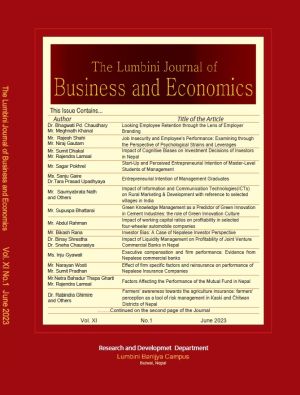Effect of firm specific and macroeconomic factors on profitability of Nepalese insurance companies
DOI:
https://doi.org/10.3126/ljbe.v11i1.54331Keywords:
Return on asset, return on equity, firm size, liquidity, tangibility, dividend per share, premium growth, inflation, gross domestic product, money supplyAbstract
This study examines the effect of firm specific and macroeconomic factors on profitability of Nepalese insurance companies. Return on asset and return on equity are selected as the dependent variables. Similarly, firm size, liquidity, tangibility, dividend per share; premium growth, inflation, gross domestic product and money supply are selected as the independent variables. This study is based on secondary data of 16 insurance companies with 124 observations for the study period from 2013/14 to 2020/21. The data were collected from collected from reports published by the insurance board of Nepal, annual reports of respective insurance companies and World Bank database. The correlation coefficients and regression models are estimated to test the significance and importance of firm specific and macroeconomic factors on the profitability of Nepalese insurance companies.
The result showed that firm size have the negative impact on return on assets and return on equity. It indicates that the increase in the firm size leads to decrease the return on assets and return on equity. Similarly, the studies showed that liquidity rate have also the negative impact on return on assets and return on equity. It indicates that the increase in the liquidity leads to decrease the return on assets and return on equity. On the other hand, the studies found that tangibility have the positive impact on return on assets and return on equity. It shows that the increase in the tangibility leads to increase the return on assets and return on equity. Likewise, the studies found that dividend per share have the positive impact on return on assets and return on equity. It shows that the increase in the dividend per share leads to increase the return on assets and return on equity. Similarly, the studies found that premium growth have the positive impact on return on assets and return on equity. It shows that the increase in the premium growth leads to increase the return on assets and return on equity. Furthermore, gross domestic products have the positive impact on return on assets and return on equity. It means that increase in the gross domestic product have leads to increase the return on assets and return on equity. Moreover, inflation has the negative impact on return on assets and return on equity. It shows that increase in the inflation leads to decrease the return on assets and return on equity. Likewise, money supply has the negative impact on return on assets and return on equity. It indicates that the increase in the money supply leads to decrease the return on assets and return on equity of Nepalese insurance companies.




